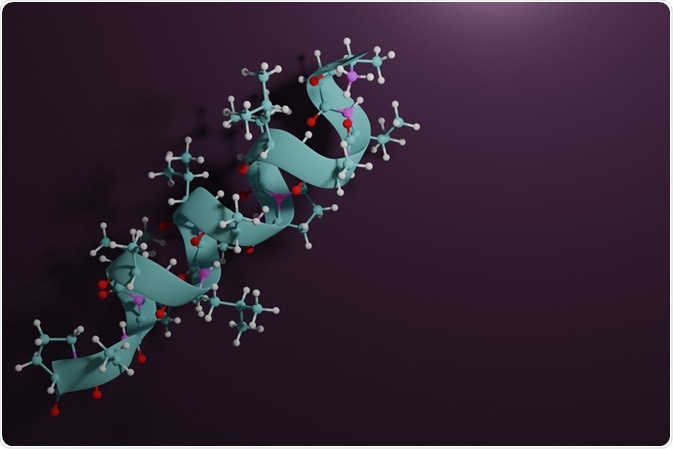Peptidomics is associated with the comprehensive analysis of all peptides in a biological sample. Instead of analyzing the sample containing the entire protein, it examines the presence of endogenous protein fragments in a sample. Scientists have applied peptidomics effectively in various scenarios such as mapping of food protein digestion, identification of bioactive peptide biomarkers of disease, detection of signaling molecules, etc.

Image Credit: sanjaya viraj bandara/Shutterstock.com
After over a decade of peptide research that had mainly focused on a few specific peptides, the term “peptidomics” was first introduced in research published in 2001. Since then, scientists had worked extensively in peptidomics and technological advancements aided this research significantly.
Peptides are characterized using various technologies such as mass spectrometry (MS), high-performance liquid chromatography (HPLC), etc., based on the target analyte. MS is used to detect a multitude of single peptides in complex biological mixtures. MS along with other methods which were designed to study peptides in proteomics were specifically modified to be implemented in peptidomics technologies.
Application of peptidomics
As stated above, peptidomics has varied applications. Some of the applications are discussed below:
Analysis of dietary proteins
Many proteins and protein fragments (peptides) remain intact throughout the digestive process. These are removed from the body via urine and stool. For instance, casein peptides, which are present in milk or yogurt, have been detected in the stomach, duodenum, and plasma of adult humans. Scientists have applied peptidomics to study how dietary proteins are catabolized in the digestive system and throughout the body.
One of the methods to study dietary proteins is by using HPLC followed by Edman sequencing. Researchers use this method to detect the release of opioid peptides in casein-fed subjects. It helps identify the persistence of functional milk peptides in the plasma of calves. This technique has also been employed to analyze casein peptides in human infants after milk or formula feeding.
MS technique has proved to be instrumental in studying peptide release during the process of digestion. LC-MS has helped detect many milk protein-derived peptides in the jejunum of adult humans after whey and casein ingestion. Peptidomics helped reveal that the digestion of milk protein is initiated within the mammary gland because of the presence of the protease enzyme in humans.
Scientists found that some protein fragments, such as peptides released from wheat protein α-gliadin in the gut, may trigger the tight junctions between the cells, which consequently, might lead to inflammation. Interestingly, peptidomics analysis has shown that varied food preparation methods, e.g., cooking, fermentation, etc., also play an important role in the release of dietary peptides in digestion.
Peptidomics in food processing
Peptidomics help analyze the peptides released from food proteins via conventional food processing. In the production of cheese, casein proteins are often curdled using exogenous enzymes, e.g., rennet. Scientists have used peptidomics to analyze exact sites of rennet cleavage on κ-casein and β-casein. Several bacteria that produce proteases are used in cheese ripening.
Peptidomics data effectively examines the cleavage sites and peptides produced by these bacteria. MS-based peptidomics analysis has recently detected casein peptides, released by proteases produced by six Streptococcus thermophilus strains that were used in the production of cheese and yogurt.
Scientists have used peptidomics technologies to reveal that different peptides are released across cheeses, e.g., Parmigiano–Reggiano, Emmental, Gouda, and cheddar. This is because these cheeses are developed using different methods including starting materials, coagulation, etc. Peptidomics can be applied in all food hydrolysates to detect which peptides are released during production. These released fragments could be subsequently investigated for their significant functional activity.
There are different kinds of allergenic food proteins such as caseins, wheat gluten, and β-lactoglobulin, which can be hydrolyzed to reduce their allergenicity. Scientists apply peptidomics to monitor the degree of degradation to determine the elimination of allergenic epitopes.
Identification of biomarkers
Peptidomics technology has been used extensively to identify biomarkers for disease. To date, scientists have detected several peptide biomarkers. For instance, levels of a fragment of β-amyloid and tau protein in cerebrospinal fluid can help identify patients with a mild cognitive impairment, which could progress to Alzheimer’s disease.
Scientists have revealed that a combination of urine peptides serves as biomarkers to detect several diseases such as chronic kidney disease, acute renal allograft rejection, diabetic nephropathy, prostate cancer, and coronary artery disease.
Detection of endogenous peptides (neuropeptides)
Apart from peptides that are released from the fermentation and digestion of dietary proteins, many hormones (e.g., insulin, prolactin, and oxytocin) and other signaling molecules are present in the body that are active endogenously as structure-specific peptides. These exogenous peptides are called neuropeptides (endogenous peptides) which are known to be the largest class of neuroactive messengers that acts as neurotransmitters, neurohormones, or neuromodulators. These exogenous peptides are associated with various physiological processes in animals.
The majority of neuropeptides are small whose size range from a few to 100 amino acids in length. Researchers have used MALDI-MS to detect hundreds of hormones and neuropeptides.
Future research
As discussed in this article, scientists have applied peptidomics in many areas, such as annotating food hydrolysates, monitoring digestion, determining the levels of the hormone, and identifying disease biomarkers. They believe improvements in peptide extraction methods, and detection instrumentation could significantly contribute to advancing peptidomics technology with accuracy. Improved software for the identification of peptide fragments with complex modification is required.
Sources:
- Foreman, E.R. et al. (2021). Peptidomics: A Review of Clinical Applications and Methodologies. Journal of Proteome Research, 20 (8), pp. 3782-3797. DOI: 10.1021/acs.jproteome.1c00295
- Schrader, M. (2018). Origins, Technological Development, and Applications of Peptidomics. In: Schrader M., Fricker L. (eds) Peptidomics. Methods in Molecular Biology, 1719. Humana Press, New York, NY. https://doi.org/10.1007/978-1-4939-7537-2_1
- Dallas, D. C. et al. (2015). Current peptidomics: applications, purification, identification, quantification, and functional analysis. Proteomics, 15(5-6), pp. 1026–1038. analyticalsciencejournals.onlinelibrary.wiley.com/.../pmic.201400310
- Schrader, M. et al. (2014). Historical perspective of peptidomics. EuPa Online proteomics.3, pp. 171-182. https://doi.org/10.1016/j.euprot.2014.02.014
Further Reading
Last Updated: Jul 26, 2022